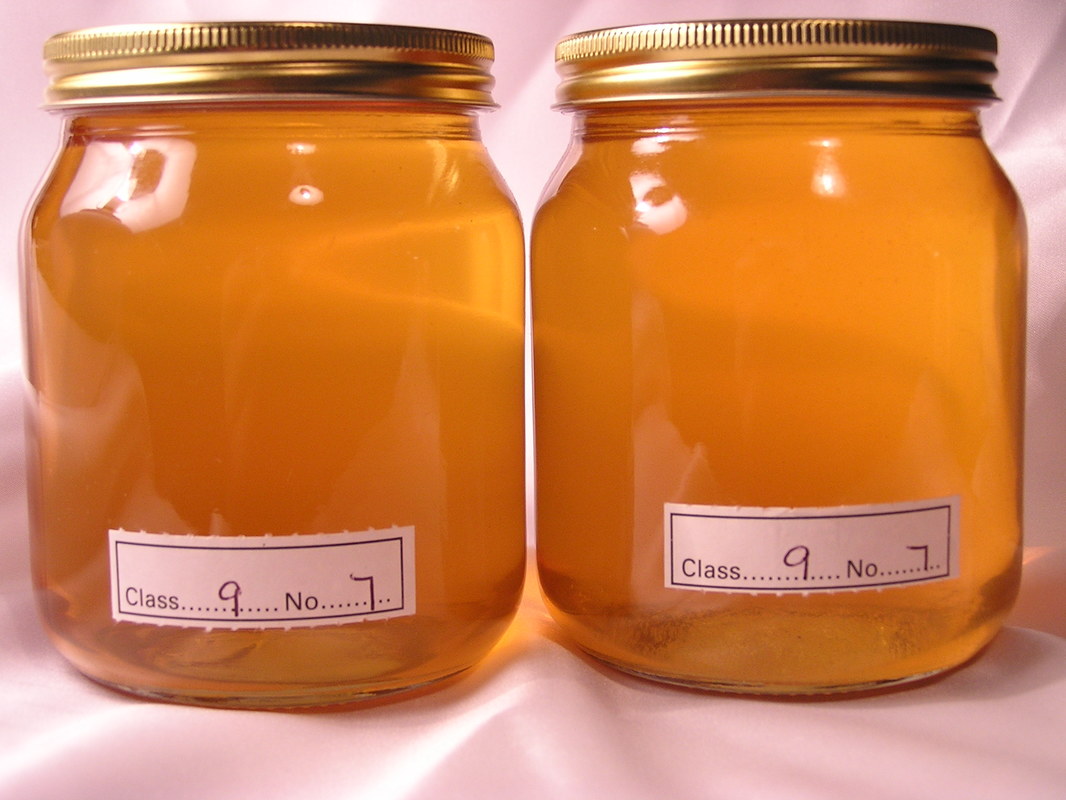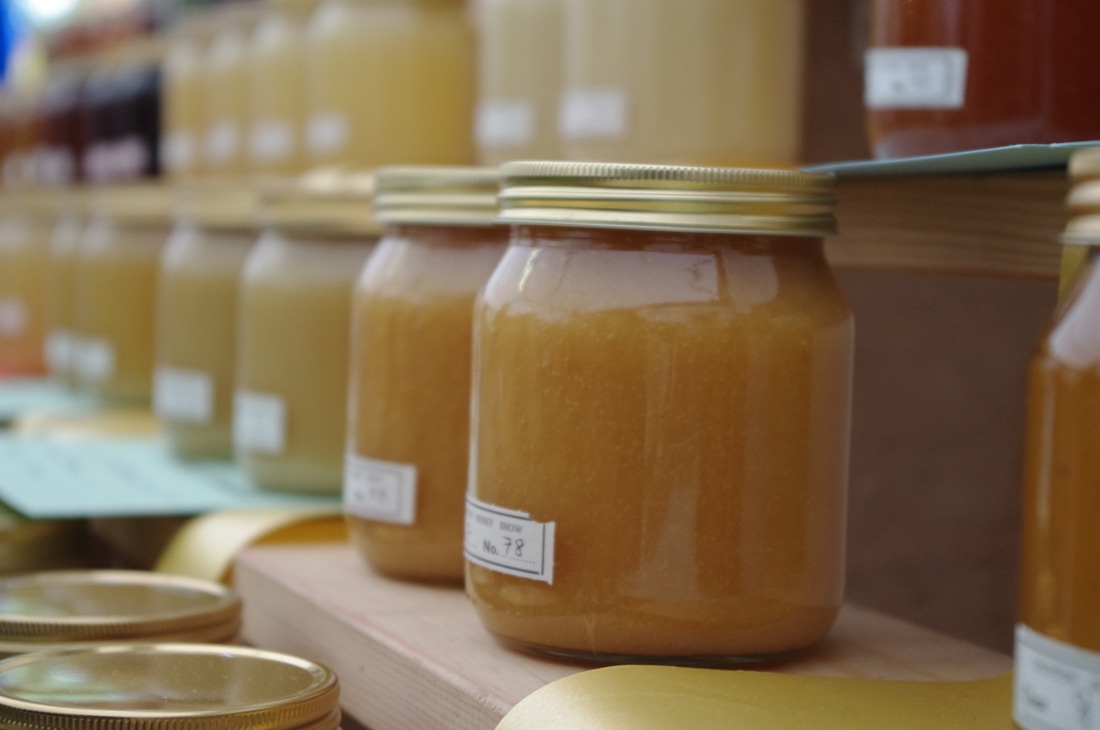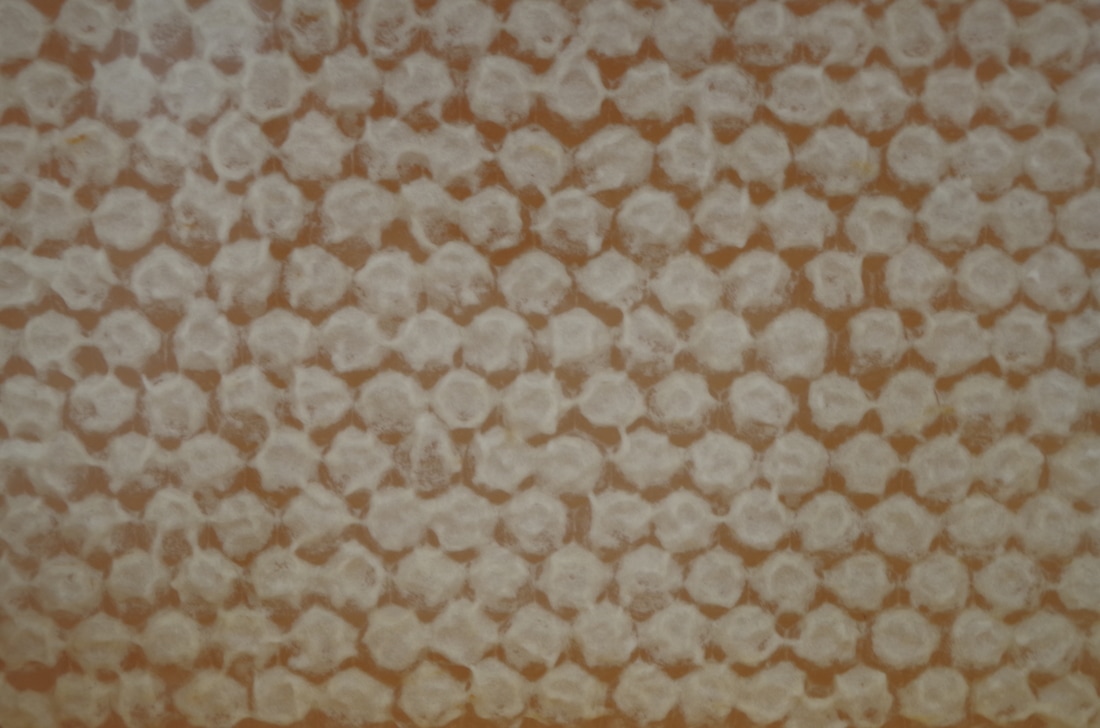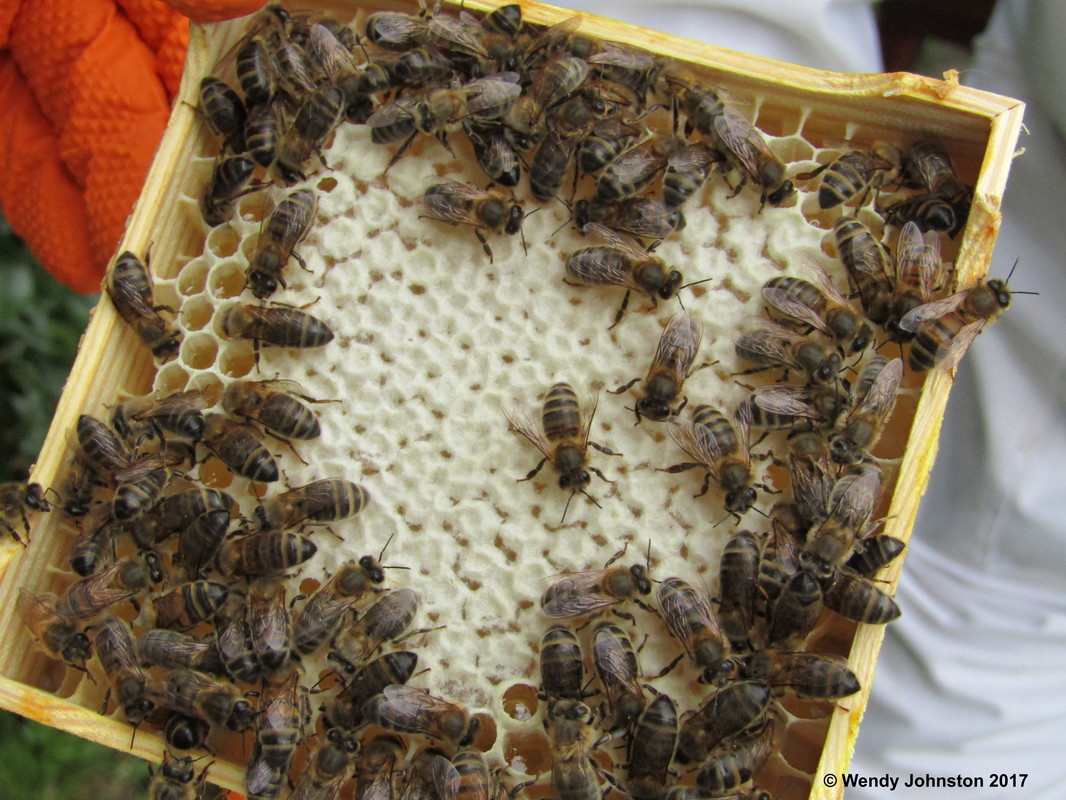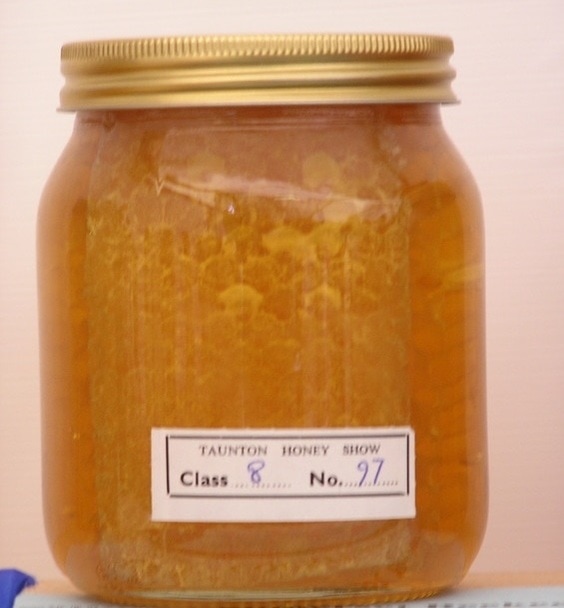In marketing anything, there are three basic aspects to consider: Quality; Presentation and Packaging.
On this page, we will take a close look at these three aspects, and how they apply to selling honey, as well as considering Hygiene and Point of Sale.
On this page, we will take a close look at these three aspects, and how they apply to selling honey, as well as considering Hygiene and Point of Sale.
Quality
The quality of honey is taken care of by the bees. It is a near perfect product when it comes from the hive, and as long as the beekeeper does nothing to impair that quality, no further action is necessary. Even so, care must be taken to maintain high standard of hygiene during the extraction process, and anyone preparing honey for sale is recommended to read the relevant standards on honey safety.
Presentation
Presentation, on the other hand, can be improved upon, or at least, varied. Bees produce the honey in one form only i.e. comb honey, but we have learnt how to extract it from the comb, and put it into containers. This opens a wide area of presentation opportunities. We can sell the honey in its run form, or as granulated or set. We can present it as Cut Comb, or in Sections, round or square, or as Chunk Honey, a combination of both comb and run honey.
Preparing honey for sale begins with the removal from the hive (see Harvesting the Crop). Preparation for comb honey starts before that, but let’s deal with one thing at a time.
Preparing honey for sale begins with the removal from the hive (see Harvesting the Crop). Preparation for comb honey starts before that, but let’s deal with one thing at a time.
Run (Runny) Honey
For the purpose of this exercise, let us assume that extracting is over, and the harvest stored away in honey buckets. After a period of time, the honey in most of these buckets will have granulated, although some buckets may still contain run honey. This is dependent upon the source of the nectar from which the honey was produced. If there is still run honey available, then obviously, this is the honey to select to sell as Run Honey.
Although it is still in its run state however, and perfectly good honey, it might not be in its best condition to present to the general public. It might have started the granulation process, impairing its clarity, or sometimes, large granular crystals form at the bottom of the container, which must be removed before the honey is placed before the consumer. Gentle warming is usually the answer to both of these problems, although sometimes, large granules can be notoriously difficult to remove by melting. If this is the case, then straining through a nylon straining cloth will successfully remove them. I tend to carry out this secondary straining process in any case, as the honey is warm and will go through the straining cloth quickly, making it a very easy operation. What it is strained into, depends upon the means available to bottle the honey. Clearly, a Honey Tank with a valve is the best bet, but in the absence of any other equipment, a large jug can be put to good use. Once the honey is in the container, it should be left to stand for twenty-four hours. During this time, any air bubbles trapped in the process, will float to the top, where they can be skimmed off, prior to bottling. The jars, which are washed and perfectly dry, can then be filled with honey that will be clear, bright, and free from any surface film or sedimentary granules. It is advisable to use scales in this process to ensure that not only is adequate weight being given, but also the jars are not over filled to the point where seepage could occur under the lids. A shopkeeper will not thank you for sticky shelves.
Although it is still in its run state however, and perfectly good honey, it might not be in its best condition to present to the general public. It might have started the granulation process, impairing its clarity, or sometimes, large granular crystals form at the bottom of the container, which must be removed before the honey is placed before the consumer. Gentle warming is usually the answer to both of these problems, although sometimes, large granules can be notoriously difficult to remove by melting. If this is the case, then straining through a nylon straining cloth will successfully remove them. I tend to carry out this secondary straining process in any case, as the honey is warm and will go through the straining cloth quickly, making it a very easy operation. What it is strained into, depends upon the means available to bottle the honey. Clearly, a Honey Tank with a valve is the best bet, but in the absence of any other equipment, a large jug can be put to good use. Once the honey is in the container, it should be left to stand for twenty-four hours. During this time, any air bubbles trapped in the process, will float to the top, where they can be skimmed off, prior to bottling. The jars, which are washed and perfectly dry, can then be filled with honey that will be clear, bright, and free from any surface film or sedimentary granules. It is advisable to use scales in this process to ensure that not only is adequate weight being given, but also the jars are not over filled to the point where seepage could occur under the lids. A shopkeeper will not thank you for sticky shelves.
Set Honey
Set honey is usually sold in two forms, Soft-Set or Creamed, and Naturally Granulated. If it is naturally granulated, the granulation must take place in the jar in which it is to be sold. One of the problems with naturally granulated honey is that it can set very hard, and as it sets, it contracts away from the sides of the jar. The exposed surface becomes covered with a white patina, presenting a streaked “frosting” effect. Although there is nothing wrong with this, it produces an undesirable presentation over which the beekeeper has little control. It is for this reason that most people prefer to produce creamed honey as their “set”.
If we return to our stored honey, and inspect the buckets, which have granulated, we will find that some contain honey with a very coarse granulation, while others have granulated very smoothly, like butter. It is the latter that is best used for creaming. The very coarse honey can be melted down and sold as Run Honey. The bucket for creaming should be warmed gently either in a Warming Cabinet, or a fan oven set at no more than 50c, until the granulated honey is half melted. This 50/50 mixture will then be soft enough to be mashed with a Honey Creamer into a creamy consistency devoid of any lumps. It should then be transferred into a Honey Tank, or large jug, where it can be left to stand for twenty-four hours. The resulting air bubbles can be skimmed off prior to bottling. After bottling, the honey will tend to set a little in the jar, but it will always retain its soft spreadable consistency, and there will be no “frosting” effect
If we return to our stored honey, and inspect the buckets, which have granulated, we will find that some contain honey with a very coarse granulation, while others have granulated very smoothly, like butter. It is the latter that is best used for creaming. The very coarse honey can be melted down and sold as Run Honey. The bucket for creaming should be warmed gently either in a Warming Cabinet, or a fan oven set at no more than 50c, until the granulated honey is half melted. This 50/50 mixture will then be soft enough to be mashed with a Honey Creamer into a creamy consistency devoid of any lumps. It should then be transferred into a Honey Tank, or large jug, where it can be left to stand for twenty-four hours. The resulting air bubbles can be skimmed off prior to bottling. After bottling, the honey will tend to set a little in the jar, but it will always retain its soft spreadable consistency, and there will be no “frosting” effect
Cut Comb
Comb honey is generally considered to be the purest form of honey on the market. It is exactly as the bees produced it, and usually commands a premium price. It is also an ideal way of dealing with heather honey, which is practically impossible to extract by conventional methods. Comb honey production begins with putting frames and foundation in the hive. The foundation used, should be thin and unwired, producing a comb with a very thin midrib, and no wire reinforcement. The source of the nectar should also be considered, as ideally, we would like our comb honey to be free of granulation. Crops such as Oilseed Rape should therefore be avoided, with more desirable sources being Apple Blossom, Field Bean, Clover, and Heather.
As with combs for extraction, the cells should be sealed before removal from the hive. If a large quantity of comb honey is to be produced, a chest freezer is a useful item of equipment, even if it’s an old one. By putting the supers of comb honey straight into a freezer, it slows down granulation, and is an ideal storage facility. It is unusual to find wax moth damage in supers, but freezing also negates any possibility of this occurring. The other thing that can spoil your comb is large quantities of pollen. Although pollen is perfectly edible, and indeed sought after in health food shops, it is not desirable in the middle of a piece of comb honey. One way to avoid this is to ensure that the cut comb super is not placed next to the brood chamber. A super for extraction should be placed in between, and then this should receive any stray pollen instead of the cut comb frames. If the odd cell of pollen should appear in your piece of cut comb, all is not lost, as long as an explanation appears on the label. After all, a cell containing a brownish, muddy substance could be anything, in the eye of an uninitiated consumer. A statement such as “All pure honey will eventually granulate, and comb honey is no exception. Sometimes the comb contains a few cells of pollen which may be eaten or discarded.” will cover both eventualities.
When preparing cut comb, the combs should be removed from the freezer a couple of days before required, in order for the honey to fully thaw. It should be kept in a warm environment where there can be no risk of wax moth contamination. When the comb is fully thawed it can be dealt with in two ways.
If the frame is full and capped right into the corners, every bit can be used. The comb should be carefully cut out of the frame onto a flat, washable surface. A long, flat bladed knife is then required (a ham knife is ideal) to make the final cuts. If the comb is cut in half longitudinally, and then cut into four the other way, we have eight pieces of comb of a marketable size. They will not accurately fit the 8oz Cut Comb Container as a honey judge would require, but the aim here is to present a piece of comb honey of a size which the consumer would be happy to purchase. The thickness of course, is determined by the form of spacing used within the hive, but if this is Narrow Plastic Spacers, we achieve a piece of comb which will sit within a cut comb container, without the cappings being marred by pressure from the lid.
If the frame is not full, or not fully capped, but there is a useful area in the centre from which two or three pieces of comb could be cut, then a stainless steel Comb Cutter is an invaluable accessory. The frame should be placed flat onto the work surface, and the comb cutter pressed into it. On removal, the piece of comb comes away with the cutter, and it can then be “injected” into a cut comb container. If only the centre is removed, then the frame can be returned to the bees, and if this is done during a honey flow, they will repair the damage, and rebuild and refill the comb.
As with combs for extraction, the cells should be sealed before removal from the hive. If a large quantity of comb honey is to be produced, a chest freezer is a useful item of equipment, even if it’s an old one. By putting the supers of comb honey straight into a freezer, it slows down granulation, and is an ideal storage facility. It is unusual to find wax moth damage in supers, but freezing also negates any possibility of this occurring. The other thing that can spoil your comb is large quantities of pollen. Although pollen is perfectly edible, and indeed sought after in health food shops, it is not desirable in the middle of a piece of comb honey. One way to avoid this is to ensure that the cut comb super is not placed next to the brood chamber. A super for extraction should be placed in between, and then this should receive any stray pollen instead of the cut comb frames. If the odd cell of pollen should appear in your piece of cut comb, all is not lost, as long as an explanation appears on the label. After all, a cell containing a brownish, muddy substance could be anything, in the eye of an uninitiated consumer. A statement such as “All pure honey will eventually granulate, and comb honey is no exception. Sometimes the comb contains a few cells of pollen which may be eaten or discarded.” will cover both eventualities.
When preparing cut comb, the combs should be removed from the freezer a couple of days before required, in order for the honey to fully thaw. It should be kept in a warm environment where there can be no risk of wax moth contamination. When the comb is fully thawed it can be dealt with in two ways.
If the frame is full and capped right into the corners, every bit can be used. The comb should be carefully cut out of the frame onto a flat, washable surface. A long, flat bladed knife is then required (a ham knife is ideal) to make the final cuts. If the comb is cut in half longitudinally, and then cut into four the other way, we have eight pieces of comb of a marketable size. They will not accurately fit the 8oz Cut Comb Container as a honey judge would require, but the aim here is to present a piece of comb honey of a size which the consumer would be happy to purchase. The thickness of course, is determined by the form of spacing used within the hive, but if this is Narrow Plastic Spacers, we achieve a piece of comb which will sit within a cut comb container, without the cappings being marred by pressure from the lid.
If the frame is not full, or not fully capped, but there is a useful area in the centre from which two or three pieces of comb could be cut, then a stainless steel Comb Cutter is an invaluable accessory. The frame should be placed flat onto the work surface, and the comb cutter pressed into it. On removal, the piece of comb comes away with the cutter, and it can then be “injected” into a cut comb container. If only the centre is removed, then the frame can be returned to the bees, and if this is done during a honey flow, they will repair the damage, and rebuild and refill the comb.
Sections
The most traditional way of producing honey must be the square wooden sections. Greatly sought after by traditionalists and lovers of pure food, sections always command a premium price in the market place. They are produced by the use of Section Racks instead of supers, or a smaller number can be obtained by using Hanging Section Holders. These are special frames into which can be placed three wooden sections filled with foundation. They can then be placed in the centre of a normal super, each flanked with a Divider to ensure that the face of the comb constructed is flat and even.
The difficulty of preparing sections for market is in the cleaning. As with any other moveable part within the hive, the bees administer a liberal helping of propolis to the wood surface, and this must be scraped off before presenting to the consumer. This can be done with a knife or a razor blade, but care must be taken to avoid damaging the comb, or spoiling it with crumbs of propolis. A marketable section should be filled with honey, and capped on both sides. The modern equivalent of this traditional way of producing honey is the Round Sections. These can only be produced in a section rack however, not in a standard super, so setting up costs can be high. When storing sections, the same freezing technique can be applied as with cut comb. To avoid “travel staining” of combs, by the bees constant movement over them within the hive, both sections, and comb honey should be removed from the hive as soon as capping is completed.
The difficulty of preparing sections for market is in the cleaning. As with any other moveable part within the hive, the bees administer a liberal helping of propolis to the wood surface, and this must be scraped off before presenting to the consumer. This can be done with a knife or a razor blade, but care must be taken to avoid damaging the comb, or spoiling it with crumbs of propolis. A marketable section should be filled with honey, and capped on both sides. The modern equivalent of this traditional way of producing honey is the Round Sections. These can only be produced in a section rack however, not in a standard super, so setting up costs can be high. When storing sections, the same freezing technique can be applied as with cut comb. To avoid “travel staining” of combs, by the bees constant movement over them within the hive, both sections, and comb honey should be removed from the hive as soon as capping is completed.
Chunk Honey
Of all the forms of honey presentation, this is probably the most attractive. For the consumer, it is the best of both worlds, a piece of comb within a jar of run honey. It is only a practical form of presentation however, where a quick sale is envisaged. A piece of comb within a jar of run honey will usually induce the run honey to granulate quickly, and granulated chunk honey rather defeats the object of the presentation.
The comb should be prepared in exactly the same way as a piece of cut comb. The dimensions should be such that it will just fit into the neck of the jar. It is useful to have a template for this. A margarine or ice cream container provides a convenient medium from which to cut the template, being plastic and washable. Make sure that the piece of comb is long enough to touch the underside of the jar lid, as it has a tendency to float in the run honey, and contact with the lid will help to keep it in place. Another useful tip is to place the comb in the jar a couple of days before adding the run honey. The weight of the comb will then form a seal with the bottom of the jar, again, helping to prevent movement. The presentation objective here is to be able to see the comb within the honey; therefore the run honey used should be light in colour, and clear. When adding the run honey, it is best to run it in very slowly, avoiding any turbulence likely to dislodge the comb.
The comb should be prepared in exactly the same way as a piece of cut comb. The dimensions should be such that it will just fit into the neck of the jar. It is useful to have a template for this. A margarine or ice cream container provides a convenient medium from which to cut the template, being plastic and washable. Make sure that the piece of comb is long enough to touch the underside of the jar lid, as it has a tendency to float in the run honey, and contact with the lid will help to keep it in place. Another useful tip is to place the comb in the jar a couple of days before adding the run honey. The weight of the comb will then form a seal with the bottom of the jar, again, helping to prevent movement. The presentation objective here is to be able to see the comb within the honey; therefore the run honey used should be light in colour, and clear. When adding the run honey, it is best to run it in very slowly, avoiding any turbulence likely to dislodge the comb.
Packaging
Where honey is concerned, packaging usually revolves around some sort of jar, sometimes plastic or ceramic, but more commonly glass. These come in a variety of shapes and sizes. The standard squat jar, the beehive jar, the globe jar, the hexagonal jar etc., and in a variety of sizes 454g, 340g, 227g, etc.
So there is no shortage of practical and attractive packaging for our honey, and this is further enhanced by a wide range of colourful labels. There are certain legal requirements regarding labelling, but most of these are dealt with by the label printers. The label should clearly state what is in the container i.e. “HONEY”, “COMB HONEY” or “CHUNK HONEY”. The metric weight should be clear, and the producer/packer’s name and address should appear somewhere on the jar, as should a lot number. This should start with the letter L, and then a selection of numbers, which is left to the discretion of the producer. If this is handled by the label printers, the lot numbers will be consecutive, and the beekeeper must formulate his own plan to keep track of these.
There are food and drink labelling changes from 2021 following the UK's exit from the EU. The label details must include the country of origin e.g. “Produce of UK”, and a “best before” date. In addition to these legal requirements, the label may bear other information such as county of origin (Somerset, Dorset, Wiltshire etc.), and nectar source (Heather, Apple blossom, Clover). The latter should be used with great care, as it is extremely difficult to identify a single source in this country, and if the statement is found to be false, the beekeeper is liable. There are other labels, not governed by regulations, which can be very useful when selling honey to a retail outlet. Whilst sitting on a shop shelf, it could be subject to tampering, or run honey might begin to granulate. Semi granulated honey has a cloudy appearance, and whilst we know granulation is a natural process, to the uninitiated, it might appear to be “going off”. A label, which explains granulation, is therefore useful, and a Tamper Evident label is advisable. This is simply a paper seal running from the lid to the jar, ensuring that removal of the lid would immediately be recognised.
Cut comb is also sold by weight, but this is more difficult to control, as the weight is determined by the dimensions of the comb, and the density of the honey. The weight is usually rounded down to the nearest 10g, and priced accordingly. Attractive labels, or a cardboard sleeve, which slides over the container, can enhance the appearance of the rather plain white plastic cut comb container.
Square sections are usually priced “each”, as it is practically impossible to control the weight. The most attractive form of packaging is the Section Case, which is a cardboard box with a plastic window, which shows off the comb to great advantage. All other honey regulations apply
So there is no shortage of practical and attractive packaging for our honey, and this is further enhanced by a wide range of colourful labels. There are certain legal requirements regarding labelling, but most of these are dealt with by the label printers. The label should clearly state what is in the container i.e. “HONEY”, “COMB HONEY” or “CHUNK HONEY”. The metric weight should be clear, and the producer/packer’s name and address should appear somewhere on the jar, as should a lot number. This should start with the letter L, and then a selection of numbers, which is left to the discretion of the producer. If this is handled by the label printers, the lot numbers will be consecutive, and the beekeeper must formulate his own plan to keep track of these.
There are food and drink labelling changes from 2021 following the UK's exit from the EU. The label details must include the country of origin e.g. “Produce of UK”, and a “best before” date. In addition to these legal requirements, the label may bear other information such as county of origin (Somerset, Dorset, Wiltshire etc.), and nectar source (Heather, Apple blossom, Clover). The latter should be used with great care, as it is extremely difficult to identify a single source in this country, and if the statement is found to be false, the beekeeper is liable. There are other labels, not governed by regulations, which can be very useful when selling honey to a retail outlet. Whilst sitting on a shop shelf, it could be subject to tampering, or run honey might begin to granulate. Semi granulated honey has a cloudy appearance, and whilst we know granulation is a natural process, to the uninitiated, it might appear to be “going off”. A label, which explains granulation, is therefore useful, and a Tamper Evident label is advisable. This is simply a paper seal running from the lid to the jar, ensuring that removal of the lid would immediately be recognised.
Cut comb is also sold by weight, but this is more difficult to control, as the weight is determined by the dimensions of the comb, and the density of the honey. The weight is usually rounded down to the nearest 10g, and priced accordingly. Attractive labels, or a cardboard sleeve, which slides over the container, can enhance the appearance of the rather plain white plastic cut comb container.
Square sections are usually priced “each”, as it is practically impossible to control the weight. The most attractive form of packaging is the Section Case, which is a cardboard box with a plastic window, which shows off the comb to great advantage. All other honey regulations apply
Hygiene
A chapter on preparing honey for market would not be complete without mentioning hygiene. Like it or not, we are part of the food industry, with all the adhering health and hygiene regulations. At any time, an officer from the Trading Standards Office could visit us, and ask to see our extracting and bottling arrangements. Because most beekeepers are hobbyists, producing a relatively small volume of honey each year, custom-built honey rooms are few and far between. Most honey preparation takes place in the kitchen, and there are very few kitchens in the Country, that would pass the stringent rules applied to the large food processors. It is therefore essential that we maintain our own rules surrounding the preparation of honey.
A washable overall is not difficult to arrange, and perhaps something to cover the hair. Water should be on hand to deal with sticky fingers and utensils. All equipment must, by law, be of stainless steel, or food grade polythene, and, needless to say, pets should be banned from the kitchen whilst the operation is in progress. We are dealing with not just a food, but a delicate health food, and we must act accordingly. It is worth reading the government guidance on honey regulations from the food standards agency.
A washable overall is not difficult to arrange, and perhaps something to cover the hair. Water should be on hand to deal with sticky fingers and utensils. All equipment must, by law, be of stainless steel, or food grade polythene, and, needless to say, pets should be banned from the kitchen whilst the operation is in progress. We are dealing with not just a food, but a delicate health food, and we must act accordingly. It is worth reading the government guidance on honey regulations from the food standards agency.
Point of Sale
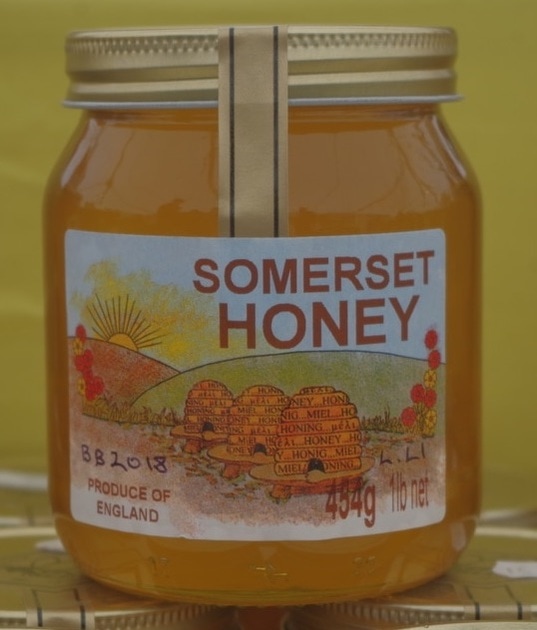
Having produced a superb product, and presented it in the best possible way, we now face the ultimate test of placing it before the discerning consumer. Will she buy it? Well, there are several things we can do at the point of sale to tip the balance. If we sell it to a retailer of course, the onus is upon them to affect the sale, but we can achieve a much greater return for our product if we sell direct. There are several options: Sales at the door; Farmers Markets; Shows and Events; sales to work colleagues etc
First of all the price should be determined. Care needs to be taken here, for if it is priced too high, resistance might be met. On the other hand, if it is priced too low, this can be worse. It can have a degrading effect on the product, and consumers will ignore it because “there must be something wrong with it”. Bear in mind that we are selling a premium product unlike any other product on the market. In this country, we are only capable of supplying a small percentage of the national demand, so we are in a “seller’s market”. Undercutting other beekeepers in such a situation would be ludicrous. Talk to other beekeepers to get a feel for what a sensible price should be.
When selling at markets, shows or village fetes, display is important. The table cover used should have the effect of making the honey stand out. A plain cloth is best, designs distract from the product, and a dark colour, green, blue, or even black. The cloth should reach the floor in the front and at the sides, providing an unseen area under the table, where backup stock etc. can be stored. One should try to achieve some height on the flanks of the display by the use of display stands. A display on one level can be very boring. A variety of differing shapes and sizes of jars will make the display more interesting, but there is aesthetic value to be gained by running the same label theme throughout. Individual jars can be enhanced by decorative lids, or a piece of gingham used as a lid cover, or perhaps a piece of ribbon tied strategically around the necks of selected jars. If backing boards are available behind your table, what about displaying some pictures depicting bees and beekeeping, reminding customers of the link with nature. And finally, what about yourself. By wearing something, which compliments the display, you yourself can enhance the overall appearance of the stand. I know it all seems a lot of trouble to go to, but the quality of the product that we are selling takes some living up to.
First of all the price should be determined. Care needs to be taken here, for if it is priced too high, resistance might be met. On the other hand, if it is priced too low, this can be worse. It can have a degrading effect on the product, and consumers will ignore it because “there must be something wrong with it”. Bear in mind that we are selling a premium product unlike any other product on the market. In this country, we are only capable of supplying a small percentage of the national demand, so we are in a “seller’s market”. Undercutting other beekeepers in such a situation would be ludicrous. Talk to other beekeepers to get a feel for what a sensible price should be.
When selling at markets, shows or village fetes, display is important. The table cover used should have the effect of making the honey stand out. A plain cloth is best, designs distract from the product, and a dark colour, green, blue, or even black. The cloth should reach the floor in the front and at the sides, providing an unseen area under the table, where backup stock etc. can be stored. One should try to achieve some height on the flanks of the display by the use of display stands. A display on one level can be very boring. A variety of differing shapes and sizes of jars will make the display more interesting, but there is aesthetic value to be gained by running the same label theme throughout. Individual jars can be enhanced by decorative lids, or a piece of gingham used as a lid cover, or perhaps a piece of ribbon tied strategically around the necks of selected jars. If backing boards are available behind your table, what about displaying some pictures depicting bees and beekeeping, reminding customers of the link with nature. And finally, what about yourself. By wearing something, which compliments the display, you yourself can enhance the overall appearance of the stand. I know it all seems a lot of trouble to go to, but the quality of the product that we are selling takes some living up to.
